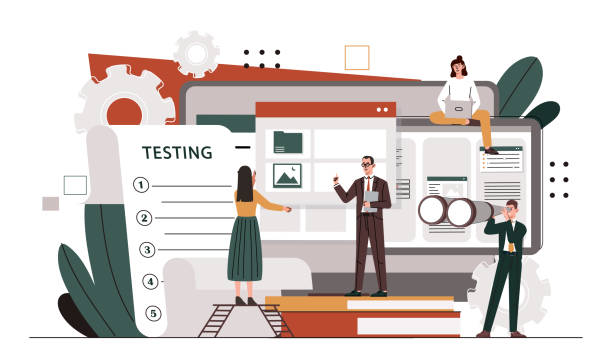Introduction to Responsive Website Design and its Importance

Today, web browsing is no longer limited to large screens; smartphones, tablets, laptops, and even smartwatches all provide ways to access online content.
In this diverse world of devices, #Responsive_Web_Design is no longer an option, but an undeniable necessity.
This design approach ensures that your website is displayed in the best possible way, regardless of the user’s screen size, and provides a seamless user experience.
This is a fundamental educational step for anyone who wants to succeed in today’s digital world.
Responsive web design means building websites that can adapt themselves to the size and orientation of the user’s device screen, whether it’s a desktop computer or a small smartphone.
This flexibility ensures that content, images, and user interface elements are optimally arranged and prevents unwanted horizontal scrolling.
Without responsive website design, users on different devices face problems such as very small fonts, off-screen images, or unclickable buttons, which quickly lead to site abandonment.
This raises questionable content as to whether your business truly cares about its users. The importance of this issue is not limited to user experience; search engines like Google also give higher rankings to responsive websites, which means improved SEO and greater visibility.
Did you know 94% of a first impression of a company is related to its website design?
RasaWeb helps you create the best first impression by offering professional corporate website design services.
✅ Create a professional and trustworthy image for your brand
✅ Easier attraction of potential customers and improved online presence
⚡ Get free consultation for corporate website design
Core Principles and Techniques in Responsive Web Design

To effectively implement responsive website design, understanding its core principles and techniques is crucial.
These principles include the use of Fluid Grids, Flexible Images, and Media Queries in CSS.
Flexible layouts use relative units like percentages or ems instead of fixed pixel units, allowing elements to adjust their size based on the screen size.
This is an important explanation for how a website works on different devices.
Flexible images also ensure, using CSS properties like max-width: 100%, that images never exceed the size of their container and do not disrupt the layout.
But the heart of responsive website design is Media Queries.
Media Queries allow designers to apply different CSS rules based on device characteristics such as screen width, height, orientation, or resolution.
For example, you can specify that on smaller screens, columns stack one below the other instead of side-by-side, or font sizes are reduced.
This specialized approach requires deep knowledge of HTML and CSS.
A precise understanding of these tools allows you to have complete control over how your website is displayed on any device and to provide a flawless user experience.
These techniques are the foundation for structuring a modern and accessible website for all users, anytime and anywhere.
Mobile-First Approach and its Advantages

In the past, web design usually started with desktop considerations and then scaled down for smaller mobile devices.
However, with the significant increase in mobile usage for internet access, the Mobile-First approach has emerged as a golden guideline in responsive web design.
This approach suggests designing and coding for the smallest screens first (i.e., mobile), and then gradually adding more features and details for larger screens (tablet and desktop).
This analytical and strategic perspective has several advantages.
Firstly, given the space and bandwidth limitations on mobile, designers are forced to focus on essential content and functionalities, leading to cleaner, more efficient, and user-friendly designs.
This in itself is a very valuable educational lesson for designers.
Secondly, because CSS codes for mobile are smaller in size, website loading is faster, which is crucial for mobile users who often use slower internet connections.
This loading speed also has a positive impact on SEO.
Thirdly, mobile-first design helps prevent the addition of unnecessary desktop codes that can make the site heavy.
Finally, this approach ensures that the user experience on mobile devices, which now constitute the majority of web users, is prioritized and never considered an “afterthought.”
This approach is not just a specialized trend but a requirement for success in today’s web world.
| Feature | Mobile-First | Desktop-First |
|---|---|---|
| Design Starting Point | Smallest screen (mobile) | Largest screen (desktop) |
| CSS Code Complexity | Adding capabilities for larger displays (min-width) |
Removing or hiding elements for smaller displays (max-width) |
| Performance | Usually loads faster, optimized for mobile | May include unnecessary code for mobile |
| Focus | Essential content and user experience | Rich and detailed design |
| SEO Optimization | Higher score from search engines due to speed and compatibility | May require more optimization for mobile |
Tools and Frameworks Assisting Responsive Design

To accelerate and facilitate the responsive design process, numerous tools and frameworks have been developed to help designers and developers create responsive websites more efficiently.
Bootstrap (Bootstrap), as one of the most popular CSS frameworks, greatly simplifies the creation of responsive pages by providing a ready-made grid system and pre-built UI components.
This is a practical and comprehensive guide to getting started.
By simply adding a few classes to your HTML elements, you can make them responsive.
In addition to Bootstrap, frameworks like Foundation and Bulma are also powerful options, each with its own specific features and design philosophies.
However, regardless of frameworks, core CSS technologies like Flexbox and Grid Layout play an irreplaceable role in responsive website design.
Flexbox is ideal for one-dimensional content arrangement (a row or a column) and allows you to easily align and distribute elements.
Grid Layout, which is newer, allows you to easily create more complex and two-dimensional layouts (rows and columns) and have more precise control over how elements are positioned on different screens.
Learning and mastering these specialized tools will smooth your path in designing modern and efficient websites and enable you to achieve desired results with greater speed and accuracy.
These tools enhance the power of web developers to build flawless user experiences.
Are you worried that your company’s old website will drive new customers away? RasaWeb solves this problem with modern and efficient corporate website design.
✅ Increases your brand credibility.
✅ Helps attract targeted customers.
⚡ Contact RasaWeb for a free consultation!
Performance Considerations in Responsive Websites

Simply being responsive is not enough for a website; its performance must also be optimized to provide a positive user experience.
Responsive websites, especially on mobile devices with limited bandwidth, can face challenges in loading speed.
One of the most important considerations is image optimization.
Large, high-quality images can put a heavy load on a website.
Using optimized image formats like WebP, and techniques like “Lazy Loading” (بارگذاری تنبل) that load images only when the user needs them, can significantly increase site speed.
This is a crucial guide for designers.
Additionally, optimized CSS and JavaScript, file compression (Gzip Compression), and utilizing Content Delivery Networks (CDN) for faster content delivery are other important analytical solutions.
Removing unnecessary CSS and JavaScript codes and reducing HTTP requests can also help improve performance.
These challenges raise many questionable content issues for designers and developers on how to best balance visual appeal, responsiveness, and loading speed.
In summary, a fast and smooth responsive website not only improves user experience but also helps improve the site’s ranking in search engines.
Always remember that today’s users are impatient, and a slow site quickly loses users.
User Experience (UX) in Responsive Website Design

User Experience (UX) is of particular importance in responsive website design.
A responsive website should not only look correct on different screen sizes but also convey the same feel to the user across all devices and be easy to use.
This is an important educational point that visual design alone is not enough.
Designing menus and navigation for mobile devices, given the limited space, is a fundamental challenge.
Using Hamburger Menus or Bottom Navigation are common solutions that must be carefully designed to ensure easy access to content.
Appropriate sizing of buttons and clickable elements is also very important, as mobile users interact with their fingers and need sufficient space to tap.
This raises questionable content as to whether all users, regardless of their finger size, can easily use your site.
Furthermore, online forms should be simplified for filling out on touch devices; using numeric keypads for phone number and date fields, and using larger input fields, can improve the user experience.
It’s entertaining how small details can make big differences.
Overall, the goal of responsive website design is not just visual compatibility, but providing a smooth, enjoyable, and efficient user experience on any device.
Focusing on user needs in every environment is the key to successful responsive UX design.
Testing and Debugging Responsive Websites

After completing the design and development of a responsive website, the critical stage of testing and debugging begins.
This stage ensures that your site functions as expected across all target devices and browsers.
Browser developer tools such as Chrome DevTools, Firefox Developer Tools, and Safari Web Inspector offer capabilities to simulate various screen sizes and mobile devices.
These tools provide an initial and essential guide for a quick layout check.
However, simulations cannot fully replace actual testing on physical devices, as there are subtle differences in browser rendering engines, processors, and operating systems.
Real Device Testing is particularly important for identifying issues related to touch performance, actual loading speed, and specific browser incompatibilities.
Online tools like BrowserStack and CrossBrowserTesting also enable testing on hundreds of virtual devices and browsers, making the testing process much more efficient.
Additionally, CSS and HTML validation tools can help identify coding errors that might affect the site’s responsiveness.
Expertise in debugging such issues is a crucial part of the development process.
A comprehensive testing strategy, including performance testing, user experience testing, and browser compatibility testing, is essential to ensure the final quality of responsive website design.
| Test Method | Description | Advantages | Disadvantages |
|---|---|---|---|
| Browser Developer Tools (DevTools) | Simulating various screen dimensions and devices in the browser | Quick access, free, instant changes | Simulation only, may not show actual device behavior |
| Real Device Testing | Checking the website on physical phones, tablets, and laptops | Most accurate results, checking touch performance and specific device features | Requires access to multiple devices, time-consuming |
| Online Testing Tools (e.g., BrowserStack) | Access to virtual devices and browsers in the cloud | Access to a wide range of environments without needing to purchase devices | Costly, may have some latency |
| Code Validation (HTML/CSS Validators) | Checking code for syntax and standard errors | Helps identify hidden issues, improves code quality | Only identifies code errors, not responsiveness issues |
Common Challenges and Solutions in Responsive Design

Despite its numerous advantages, responsive design also comes with challenges that developers must address.
One of the main challenges is managing large and complex content on small screens.
Some websites have a large volume of information that lacks sufficient space for display on mobile devices.
The solution is to prioritize content with an analytical approach, showing only vital information on smaller devices, or using techniques such as tabs, accordions, or a “show more” feature for better content organization.
This is an important explanation regarding content strategy.
Another challenge is dealing with heavy images and videos that can severely reduce loading speed.
Solutions include using responsive images with srcset and sizes attributes in HTML, as well as optimizing and compressing multimedia files.
Additionally, ensuring the correct functioning of JavaScript scripts on different devices is also important.
Sometimes, scripts optimized for desktop encounter problems or slow down the site on mobile.
A tip here is to use lighter libraries or optimize your code for conditional loading.
Finally, there is also the challenge of maintaining and updating responsive websites.
With the evolution of devices and web standards, continuous updates are needed to maintain compatibility and optimal performance.
These processes raise many questionable content issues about how to design future-proof websites.
Does your company’s website perform as it deserves for your brand? In today’s competitive world, your website is your most important online tool. RasaWeb, specializing in professional corporate website design, helps you to:
✅ Gain customer credibility and trust
✅ Convert website visitors into customers
⚡ Get a free consultation!
Future Trends in Responsive Website Design

The world of the web is constantly evolving, and responsive website design is no exception.
New trends are emerging that will shape the future of this field and bring exciting news for designers and developers.
One of these trends is the increased use of CSS Grid Layout, which allows for the creation of more complex and flexible layouts with greater control over content.
This enables designers to create fully responsive and custom websites without the need for heavy frameworks.
Another trend is the focus on Progressive Web Apps (PWAs), which offer a combination of the best features of websites and native applications.
PWAs can work offline, send push notifications, and even be added to the device’s home screen, significantly improving the user experience.
This is an entertaining glimpse into the potential of modern web.
Furthermore, the increasing use of Artificial Intelligence (AI) and Machine Learning (ML) in optimizing website responsiveness, such as automatic image optimization or even layout personalization based on user behavior, is another future trend.
Virtual Reality (VR) and Augmented Reality (AR) are also gradually entering the web space, requiring new approaches in responsive website design to deliver rich and immersive experiences across different devices.
These developments show that the future of the web is moving towards more personalized, faster, and more immersive experiences, and responsive website design will remain at the heart of these innovations.
Conclusion and Key Recommendations

In summary, responsive website design is no longer a luxury option, but an essential standard for any website that wants to succeed in today’s digital world.
From the beginning of this article, we provided a comprehensive explanation of its importance and then delved into the details of its principles, tools, challenges, and future trends.
Adhering to these principles not only helps improve user experience but also increases site traffic, improves SEO, and ultimately, grows your business.
To succeed in responsive website design, remember that:
Firstly, always design with a “mobile-first” approach to ensure that the user experience on small devices, which account for the largest share of internet traffic, is optimized.
Secondly, leverage powerful CSS tools like Flexbox and Grid Layout to create flexible and efficient layouts.
Thirdly, take performance optimization seriously, especially for images and scripts, to ensure your site is fast and smooth.
Fourthly, do not forget regular testing and debugging on real devices and simulators to ensure full compatibility.
Finally, keep up with new trends and emerging technologies to keep your website modern and up-to-date.
This is an educational recommendation for all designers and developers: investing in responsive website design is investing in the future of the web and your online success.
Frequently Asked Questions
| Question | Answer |
|---|---|
| What is responsive website design? | It is a web design approach that ensures a website is displayed correctly on different screen sizes (such as mobile, tablet, desktop) and its layout adapts to the user’s screen size. |
| Why is responsive design important? | Given the widespread use of various devices to access the internet, responsive design provides a consistent user experience for all users, reduces bounce rates, and improves the site’s SEO. |
| How is responsive design implemented? | This type of design is often implemented using CSS3 Media Queries, Flexible Grids, and Flexible Images. |
| What are the main components of responsive design? | Includes Media Queries for applying different styles based on device characteristics, using relative units (such as percentages and em) for sizes and layouts, and using flexible images and media whose dimensions change proportionally to the available space. |
| What are the main benefits of using responsive design? | Improved user experience, reduced development and maintenance costs (compared to having separate versions for mobile and desktop), improved search engine ranking (because Google prefers it), and increased site accessibility for all users. |
And other advertising agency services by RasaWeb in advertising:
Smart Advertising Campaign: Professional optimization to increase website traffic by customizing user experience.
Smart Direct Marketing: Exclusive service for campaign management growth based on intelligent data analysis.
Smart SEO: A combination of creativity and technology to increase sales through user experience customization.
Smart Data Analysis: A combination of creativity and technology for digital branding through custom programming.
Smart Custom Software: A combination of creativity and technology for campaign management through attractive user interface design.
And over hundreds of other services in internet advertising, advertising consultation, and organizational solutions.
Internet Advertising | Advertising Strategy | Advertorials
Resources
Webramz: Comprehensive Guide to Responsive DesignIranHost: Responsive Design and its ImportanceMihanWebHost: What is Responsive Design?ParsianHost: Principles of Responsive Website Design
? To shine in the digital world and reach the peak of success, RasaWeb Afarin Digital Marketing Agency, by offering comprehensive services including professional website design and SEO, is with you to bring your business to the position it deserves.
📍 Tehran, Mirdamad Street, next to Central Bank, Southern Kazeroun Alley, Ramin Alley, P.O. Box 6


